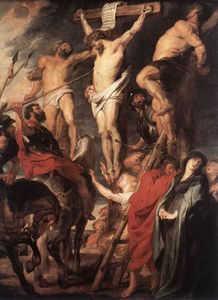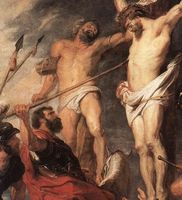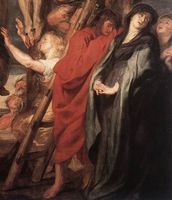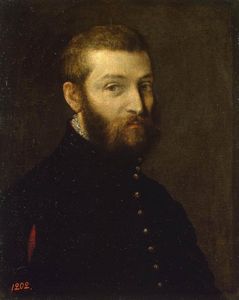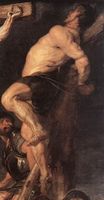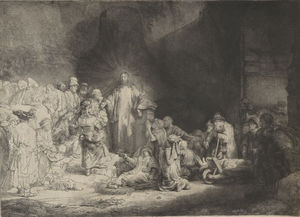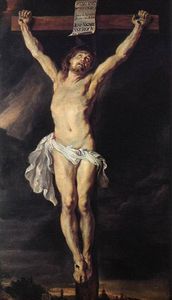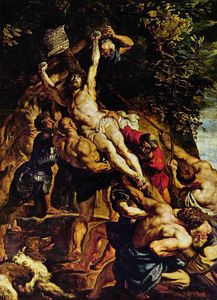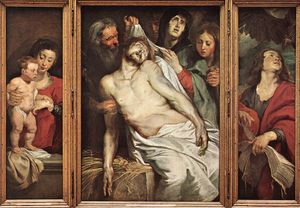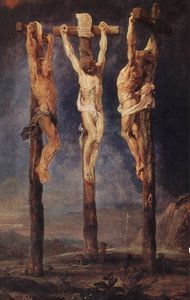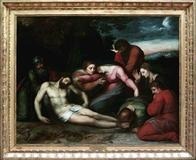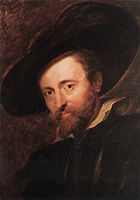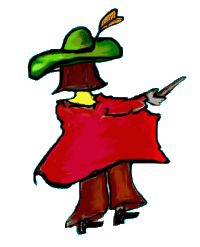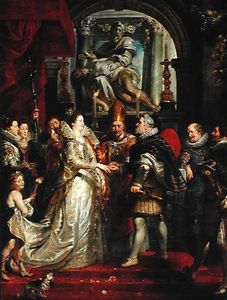Christ on the Cross
- Alternative Names:
- The Coup de Lance
- Height (cm):
- 429.00
- Length (cm):
- 311.00
- Medium:
- Oil
- Support:
- Other
- Subject:
- Scenery
- Art Movement:
- Baroque
- Created by:
- Current Location:
- Antwerp, Belgium
- Displayed at:
- Royal Museum of Fine Arts Antwerp
- Owner:
- Royal Museum of Fine Arts Antwerp
- Christ on the Cross Page's Content
- Story / Theme
- Inspirations for the Work
- Analysis
- Critical Reception
- Related Paintings
- Artist
- Art Period
- Bibliography
Christ on the Cross Story / Theme
This work was commissioned for the Duke and Duchess of Mantua of Italy in their Court.
Christ on the Cross shows Jesus 'dead' upon the cross after his horrific crucifixion ordered by Pontius Pilate on behalf of the angered Jews. The scene depicts the soldiers about to remove the dead bodies from the crosses.
The Roman soldiers check whether or not the hangers were dead and, on seeing that Jesus has passed away, the centurion Gaius Cassius Longinus said it was not necessary to break his legs. To prove this he pierced his lance in Jesus' side which caused blood and water to seep out.
Jesus' and the criminals' bodies were requested to be removed that day, as the following day was the Holy Sabbath and the Jews did not want the victims' bodies to be still hanging as it was also Passover.
The subjects here are the dead Christ, the two thieves on either side of him and Longinus. Below Christ is a very blonde Mary Magdalene who holds up her hands in protest and tries to encourage respect for Christ's dead body as Longinus is about to pierce it.
Christ's mother Mary is seen to the right wearing a black cape and her traditional blues. She is depicted in utter torment for what the soldier is about to do to her son and therefore turns her head away, unable to look.
To Mary's left, in red, is St. John who also looks away in pain. Behind the Virgin Mary is Mary the wife of Cleophas who clasps her hand in prayer as she looks to Christ.
Christ on the Cross Inspirations for the Work
Peter Paul Rubens was educated at the Flemish Art School in Antwerp and he learned to appreciate the arts and culture of Classicism which became the core inspiration for his subject matter and artistic style.
While in exile due to his father's promiscuity in Siegen, Peter and his siblings were all exposed to Catholicism as the province was still under Spanish rule. His mother was also a Catholic and this greatly influenced Rubens' choice of subject matter.
The artist's time in Italy was also greatly influential in terms of exposure to the works of Renaissance and Baroque artists such as Titian, Veronese and Tintoretto. Rubens studied classical Greek and Roman art and copied the works of the Italian masters, namely Michelangelo, Raphael and Leonardo da Vinci.
He also admired the paintings of Caravaggio and later made a copy of his Entombment of Christ. It was during this time in Rome that Rubens completed his first altarpiece commission for the Roman church of Santa Croce in Gerusalemme.
Christ on the Cross Analysis
Composition:
Rubens creates an uncommon compositional technique for this piece. The conventional placing always had the three crosses in which Christ was usually situated either to the front and middle which made him the core focus. In this work, the crosses are on a slant running from right to left and are twisted at different angles.
The figures are displayed on various planes from right to left. Subjects such as St John at the foot of the cross and the thief on the right with a contorted posture all serve to direct our gaze to Christ as the central focus. Longinus' lance also directs the eye, as well as the lances in the background.
Color palette:
In Christ on the Cross Rubens captures the light with his mastery of colors. He can be seen using tremendous tones of reds, deep browns and highlighted flesh tones to accentuate his figures.
The flesh tones work to highlight the drama of the human bodies, making the action clear to see and also defining skin texture, muscle contortions and posture. Notably, the flesh hues used to portray Christ are much lighter than his fellow hangers. His skin is clear and smooth and a white sheen is used to make his presence known.
Chiaroscuro:
Rubens still managed to define stark lighting with his own color schemes in this work despite the fact that half of the canvas is swathed in darkness. The dark top half of the image is contrasted with a light bottom half.
Light emits from the top left hand side and the clouds slightly part to show a brown/gray hue of sky as waning light falls on the subjects.
Cleverly, those standing before Christ have their faces in shadow, while His devotees who stand behind him or alongside the cross face the light, thus symbolically emphasizing their devotion. This technique also accentuates Christ as the central figure and their upward gazes and bodily gestures within the light also direct the eye to Jesus.
Christ on the Cross Critical Reception
Rubens was famed for his religious artworks and during his career he became the most renowned painter of the Catholic faith. He produced many Counter-Reformation altarpieces and gained many commissions for pantings during his visit to Italy.
The artist's altarpieces were vital in establishing Rubens as Flanders' leading painter. Works such as Christ on the Cross demonstrate the influence of the great masters on Rubens' own style and this painting is one of many examples of Baroque religious art created by Rubens.
Roger de Piles says "the painter has entered so fully into the expression of his subject that the sight of this work has the power to touch a hardened soul and cause it to experience the sufferings endured by Jesus Christ in order to redeem it."
Many critics rank Rubens alongside Rembrandt as the most important influence in Northern Europe of his time and the greatest ever Northern example of the Baroque style.
Christ on the Cross Related Paintings
Christ on the Cross Artist
Rubens was exposed to Catholicism at a young age and the fact that his mother was a Catholic greatly influenced his artistic career.
Completing his education in Italy, Rubens developed his own unique style and this led to his first commission for the Roman Catholic Church in Rome in 1608. The artist produced various works for Catholic churches during his lifetime, mainly in the form of alterpieces.
Rubens was also a keen draughtsman and would practice his human figures and dramatic scenes by sketching them profusely before executing them onto his final works.
He had a fine eye for detail in creating a sumptuous realism in his paintings to express the human condition of agony and sorrow, as depicted in Christ on the Cross. Inspired by the great masters of Italy, he used their various subject matter and created his own oeuvre and developed a style that would make him a great master in his own right.
Christ on the Cross is a great example of Rubens' innovation in compositional techniques.
Christ on the Cross Art Period
The Baroque style originated in Italy and its pioneers include great artists such as Michelangelo and Tintoretto. Baroque art centered on impersonal and generic works with an animated and energetic mood.
This art genre came into play at a time when the foundations of capitalism were being laid by the world's growing economies and art was expanding in new and exciting directions.
The success of the Baroque style was promoted by the Roman Catholic Church, which had decided in response to the Protestant Reformation that art should focus on religious themes and emotional involvement. The aristocracy also saw Baroque art as a means of demonstrating wealth and power.
One of the greatest examples of what Baroque means is conveyed in a series of paintings by Rubens created for Marie de Medici at the Luxembourg Palace in Paris.
Flemish Baroque painting developed out of the Southern Netherlands between about 1585 and 1700. Rubens played an instrumental role seventeenth-century visual culture and his works helped put Antwerp on the map as one of Europe's major artistic cities, particularly with regards to Counter-Reformation imagery.
Flemish Baroque painting saw emphasis shift to still-life, genre paintings of everyday scenes, and landscape painting. However, many artists such as Rubens preserved traditional religious subject matter.
Rubens is known for helping to develop the Baroque altarpiece. Some of his works such as Descent from the Cross reflect Counter-Reformation ideas about art and combine these with Baroque naturalism, energy and vastness.
Christ on the Cross Bibliography
Read more about Rubens and his works by referring to the literary sources listed below.
• Bertram, Anthony. The Life of Sir Peter Paul Rubens. Kessinger Publishing, 2008
• Edwards, Samuel. Peter Paul Rubens; A biography of a giant. D. McKay Co. , 1973
• Gritsay, N. Et al. Peter Paul Rubens: A Touch of Brilliance. Prestel, Oct 2003
• Kraftner, Johann. Peter Paul Rubens: 1577-1640. Thames & Hudson, 2005
• Lamster, Mark. Master of Shadows: The Secret Diplomatic Career of the Painter Peter Paul Rubens. A Talese; 1 edition, 2009
• Sutton, PC. Drawn by the Brush: Oil Sketches by Peter Paul Rubens. , Yale University Press, 2004
• Varshavskaya, Maria & Yegorova, Xenia. Peter Paul Rubens: The Pride of Life (Great Painters). Parkstone Press Ltd, 1997
• White, Christopher. Peter Paul Rubens: Man and Artist. Yale University Press, 1987

